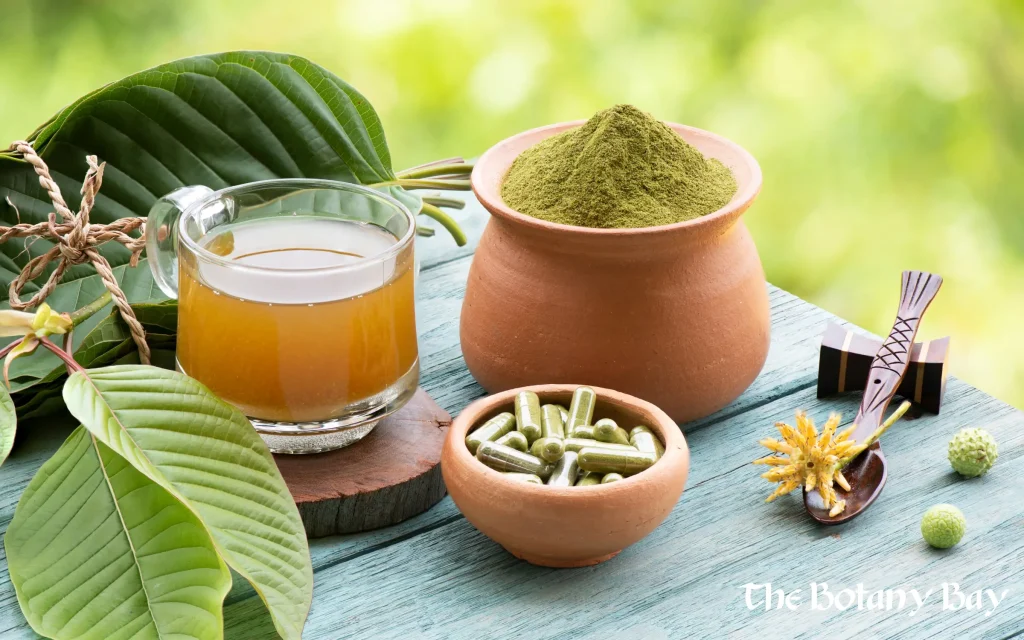Understanding Kratom
Your Comprehensive Guide to Kratom (Mitragyna speciosa)
At The Botany Bay, we believe that informed customers are empowered customers. This guide breaks down what kratom is, how it works, its potential benefits, legal status, safe usage, and how our commitment to quality ensures every product is responsibly sourced and lab-tested.

What is Kratom?
Kratom (Mitragyna speciosa) is a tropical evergreen tree native to Southeast Asia, primarily Thailand, Indonesia, Malaysia, and Papua New Guinea. Its leaves contain natural alkaloids — primarily mitragynine and 7-hydroxymitragynine — that interact with the body’s receptors and may produce stimulant or sedative effects, depending on the dosage.
Kratom has a long history of traditional use for energy, focus, and relief from discomfort. It is typically consumed in powdered leaf form, capsules, or brewed as a tea.
From Leaf to Effect: How Kratom Works
Alkaloid Action
Kratom’s primary active compounds — mitragynine and 7-hydroxymitragynine — bind to opioid receptors in the brain, but their effects are not identical to synthetic opioids. At lower doses, kratom may act as a mild stimulant, promoting alertness and focus. At higher doses, it may have calming or sedative effects.
Dosage Matters
Low dose (1–5g): Energy, sociability, focus
Moderate dose (5–8g): Relaxation, discomfort relief
High dose (8g+): Sedative effects, strong discomfort relief
⚠️ Everyone’s body chemistry is different. Start low, go slow.

How is Kratom sourced?
Kratom comes from the leaves of certain trees and is actually from the same family as coffee! Flip this box to learn more…
Native to Southeast Asia
Kratom is harvested from mature trees in Southeast Asia. Leaves are picked at various stages of maturity (green, red, or white vein), then dried and ground into powder. The drying process and vein color influence the alkaloid profile and effect.
Key Difference Between Kratom Strains
There are three main types of Kratom: Red vein, green vein, and white vein. Flip this box to learn more about their differences.
Vein Colors
- Red Vein: Often used for calm, rest, and discomfort relief
Green Vein: A balanced strain offering mild energy and mood support
White Vein: Known for stimulating and focus-enhancing effects
Legality Status of Kratom
Federal Law
Kratom is not a federally scheduled substance in the U.S. As of now, it is legal at the federal level, but the FDA does not approve it as a dietary supplement.
State-by-State Laws
Kratom laws vary significantly. While many states allow kratom sales, some have placed restrictions or bans.
✅ Legal in Kentucky: Kratom is currently legal to sell and use in Kentucky.
⚠️ Always check your local and state laws, as legislation may change.
📌 Disclaimer: Kratom laws are evolving. It is your responsibility to ensure compliance with current regulations before purchasing or using kratom.

Kratom vs. Caffeine vs. CBD
While all three are plant-derived compounds, their effects and mechanisms vary:
Kratom: Dose-dependent; stimulant at low doses, sedative at high doses
Caffeine: Always stimulating; short duration
CBD: Non-intoxicating; interacts with the endocannabinoid system for calming effects
In short:
Kratom = Dual-purpose botanical (stimulate or relax)
Caffeine = Pure stimulant
CBD = Calming, non-stimulant support
Types of Kratom - Different Vein Colors
Kratom is categorized by the color of the vein running through its leaves, which serves as a visual indicator of the leaf’s alkaloid profile at the time of harvest. This classification is similar to how cannabis is grouped into sativa or indica based on physical traits like plant height and structure. The three true vein colors—red, green, and white—are determined by the maturity of the leaf and the way it’s processed. These colors give users a general idea of the potential effects of the final kratom powder. While other colors like yellow or gold are sometimes mentioned, they are not actual vein colors but rather blends or the result of specialized drying techniques that modify the original red, green, or white strains. As the leaves mature they change from white, to green, to red.
About Red Vein Kratom
Red vein kratom is known for its calming and relaxing properties. It typically comes from more mature kratom leaves and is often chosen for stress relief, mood support, or evening use. Some users also report mild discomfort relief with certain red strains.
About Green Vein Kratom
Green vein kratom offers a balanced effect profile, sitting between red and white strains. It’s often described as providing mild energy and focus with a touch of mood enhancement. Green vein strains are popular for daytime use without being overly stimulating or sedating.
About White Vein Kratom
White vein kratom is typically the most stimulating and energizing of the three. It’s often used to promote alertness, motivation, and focus—making it a go-to for early-day productivity. Some users compare its effects to a natural pick-me-up.
How to Use Kratom
Powder (Most Popular Form)
Mix with water, juice, or smoothies. Can have a strong taste but offers flexible dosing.
Capsules
Pre-measured and convenient for beginners or on-the-go use. Effects may take longer due to digestion.
Tea
Steep dried kratom leaves or powder in hot water. Some users add lemon to improve taste and effectiveness.
Extracts
Concentrated kratom liquid or resin for experienced users seeking a more potent effect.
👇 Tips for Beginners
Start with a low dose (1–2g)
Wait 45–60 minutes before considering more
Stay hydrated — kratom can be dehydrating
Avoid mixing with alcohol or prescription medications
Use kratom in a safe, relaxed environment
🧪 Kratom and Drug Testing
Standard drug tests typically do not screen for kratom. However, some extended panels may detect mitragynine. If you’re subject to testing, use with caution.
🔍 Lab Testing & Product Transparency
Your safety is our priority. All kratom products we carry are tested by certified third-party labs to ensure:
Potency – Accurate alkaloid content
Purity – Free from contaminants like heavy metals, mold, and bacteria
Freshness – Properly stored and packaged for quality
We believe in transparency, so you always know what you’re putting into your body.
⚠️ Disclaimer
This content is for informational purposes only and has not been evaluated by the FDA. Kratom is not intended to diagnose, treat, cure, or prevent any disease. Always consult with a healthcare provider before using kratom, especially if you have health conditions or are taking medications.
Is Kratom safe?
Will kratom get me high?
Is kratom addictive?
Can I drive on kratom?
Buy Kratom Online
Browse our broad selection of kratom products from traditional powder in a large variety of sizes, to capsules, and extract options.
Shop Kratom HereNEWSLETTER
Sign up to our newsletter to keep updated with our latest offers and products.
© 2025 The Botany Bay All Rights Reserved
Disclaimer:
Some products sold by The Botany Bay are not scheduled under U.S. federal law but may be subject to state or local restrictions. The Botany Bay conducts due diligence and restricts orders to jurisdictions where these products are legal. Orders placed to prohibited areas will not be fulfilled. However, it remains the customer’s responsibility to ensure compliance with any applicable local, state, or international laws before purchasing. These products have not been evaluated by the FDA and are not intended to diagnose, treat, cure, or prevent any disease.
Kratom Disclaimer:
This product is not available for shipment to the following states: Alabama, Arkansas, Indiana, Louisiana, Rhode Island (until April 1, 2026), Vermont, and Wisconsin; or the following localities: Sarasota County (Florida); San Diego, Oceanside, Newport Beach, and unincorporated San Diego County (California); Alton, Jerseyville, Edwardsville, Glen Carbon, and Godfrey (Illinois); Denver, Monument, and Parker (Colorado); and Union, Alcorn, Lowndes, Monroe, and Tishomingo Counties, as well as the cities of Columbus, Oxford, Ridgeland, Corinth, Belmont, and Gluckstadt (Mississippi).
Cannabinoid Disclaimer:
This product is not available for shipment to states that restrict or ban hemp-derived cannabinoids, including Alaska, Arizona, Arkansas, Colorado, Delaware, Hawaii, Idaho, Iowa, Mississippi, Montana, Nevada, New York, North Dakota, Rhode Island, Utah, and Vermont; or to jurisdictions with specific local prohibitions on psychoactive hemp derivatives (e.g., Delta-8, THCA).
Disambiguation Disclaimer: The Botany Bay is not affiliated with Botany Farms.
- 0 Items
- View Cart
